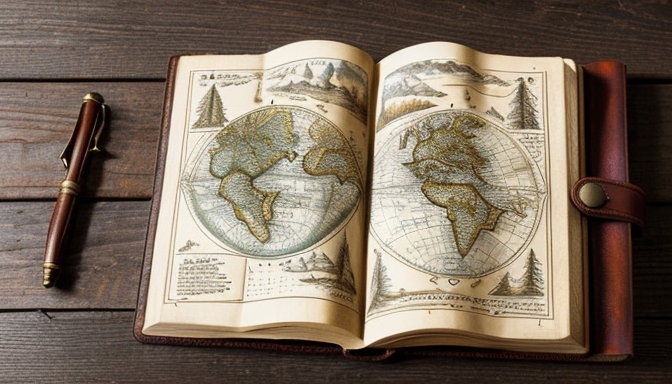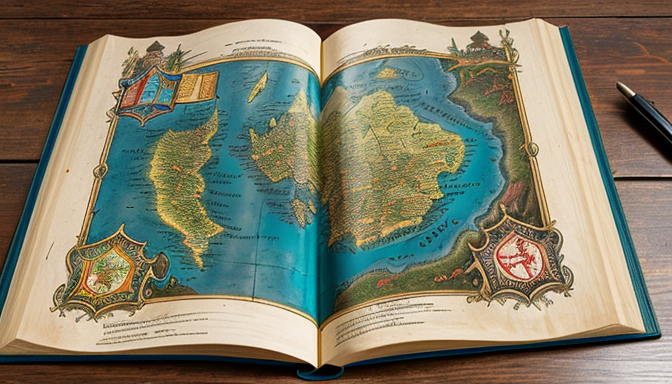When we dive into the pages of our favorite novels, the worlds they create often feel as real as our own. One of the most powerful tools in this world-building arsenal is the fictional map. These intricate designs do more than just decorate the pages; they act as a gateway into realms filled with adventure and intrigue. Imagine holding a map of Middle-earth or Narnia in your hands—suddenly, the vast landscapes, towering mountains, and winding rivers leap off the page, inviting us to explore every nook and cranny.
Fictional maps are essential for establishing the geography of a story, helping readers visualize settings and understand the relationships between different locations. For instance, when we see the borders of kingdoms or the layout of a bustling city, it fuels our imagination. We can almost hear the whispers of the characters as they traverse these lands. A well-crafted map can enhance the narrative, allowing us to follow character journeys with a sense of direction, much like a treasure hunt where each landmark holds a clue to the unfolding story.
Moreover, these maps serve as narrative devices. They can foreshadow events, reveal character motivations, and guide plot development. Think about how a hidden valley or a treacherous mountain pass can change the course of a hero’s journey. Just as a compass guides a traveler, a fictional map can steer the reader’s emotions and expectations, making the reading experience all the more engaging.
The Role of Maps in World-Building
When you dive into a new book, have you ever felt like you were stepping into a whole new universe? Fictional maps are the secret keys that unlock these immersive worlds, guiding us through intricate landscapes and vibrant realms. Imagine flipping through the pages of a fantasy novel and landing on a beautifully illustrated map. Suddenly, the story transforms from mere words into a vivid reality, where kingdoms rise and fall, and every mountain and river tells a tale of its own.
Maps are not just pretty pictures; they are essential tools that help us understand the geography of the story. They establish the layout of different locations, allowing readers to visualize how far a character must travel or the obstacles they might face along the way. For instance, consider the vast lands of Middle-earth in J.R.R. Tolkien’s works. The detailed map provides context for the epic journey of Frodo and Sam, making their quest feel all the more tangible.
Moreover, maps can also highlight landforms and kingdom borders, which play a crucial role in the narrative. They can reveal the political tensions between realms or the natural barriers that characters must overcome. For example, a treacherous mountain range might symbolize the struggles a hero faces, while a serene river could represent a journey of peace. This spatial awareness enriches the reader’s experience and deepens their connection to the story.
In essence, fictional maps are the foundation of world-building. They invite readers to explore, to question, and to imagine. So, the next time you find yourself lost in a fictional universe, take a moment to appreciate the map that brought it all to life. It’s not just a guide; it’s a portal to adventure!

Maps as Narrative Devices
When we dive into the world of fiction, maps are not just pretty illustrations—they are powerful narrative devices that shape our understanding of the story. Imagine flipping through the pages of your favorite fantasy novel, and suddenly, you come across a detailed map of the realm. This isn’t just a backdrop; it’s a key to unlocking the plot. Maps can foreshadow events, hint at hidden treasures, or even reveal the motivations of characters. For instance, a kingdom’s borders might suggest a looming conflict, while the location of a mysterious forest could indicate a character’s journey into the unknown.
These maps serve as a visual guide that enhances the reader’s experience. They allow us to visualize the geography, helping us understand the relationships between various locations. When an author describes a treacherous mountain pass or a bustling city, the accompanying map provides context, transforming abstract descriptions into tangible experiences. Moreover, the design of these maps often reflects the culture and history of the world they represent, adding layers of depth to the narrative.
Consider a fantasy series where the map is intricately designed with various landforms—mountains, rivers, and forests. Each element can symbolize different challenges the characters face. For example, a winding river might represent a journey of self-discovery, while a vast desert could signify loneliness and isolation. Maps are not just tools for navigation; they are integral to worldbuilding, enriching the story and drawing readers deeper into the fictional universe.
Frequently Asked Questions
- Why are fictional maps important in literature?
Fictional maps are essential because they provide a visual representation of the story’s world. They help readers immerse themselves in the narrative by making the settings more tangible and relatable. Imagine trying to navigate a new city without a map; it’s the same for readers trying to follow a complex story!
- How do maps enhance character journeys?
Maps can highlight the physical and emotional journeys of characters. By visualizing their travels, readers can better understand the challenges and transformations characters undergo. It’s like having a roadmap for a road trip—every twist and turn reveals something new about the journey!
- Can maps foreshadow events in a story?
Absolutely! Maps can serve as subtle hints for future events, guiding readers to pay attention to certain locations or elements. This technique adds depth to the narrative, making the reading experience more engaging. Think of it as a treasure map where each clue leads to an exciting discovery!

Recent Comments